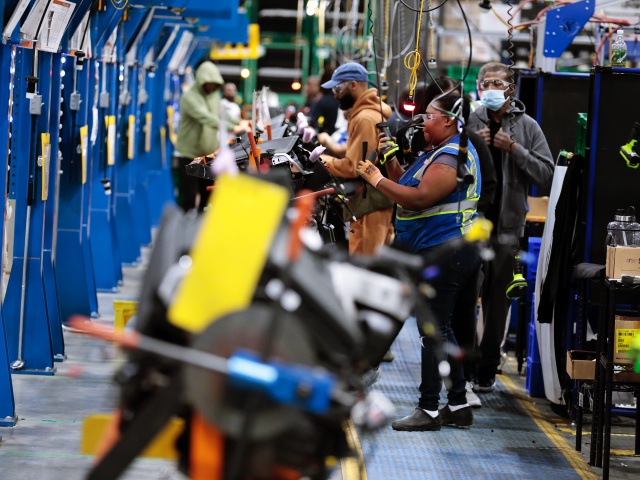Retail Sales Surge Past Expectations
It looks like the most heralded recession in history will have to wait.
The Department of Commerce said on Wednesday that retail sales jumped by three percent in January, much higher than the 1.7 percent forecast by Wall Street analysts. Core retail sales, which excludes gas stations and auto dealers, rose 2.6 percent, smashing the Econoday median forecast for a meager 0.6 percent.
This was the third year in a row in which the January retail sales figures came in higher than expected. As we wrote on Monday, Wall Street’s analysts have not caught up with the change in shopping habits that pulled holiday sales forward into September and October. This leaves them overestimating sales in November and December and underestimating sales in January.
There’s also a problem with the seasonal adjustments. These are based on pre-pandemic shopping patterns that assume big surges in sales in November and December and a huge decline in January. Sales still do rise in December; but because they do not rise by as much as they once did, the seasonal adjustments reads this as a decline. Similarly, sales fall in January, but the seasonal adjustment reads it as an increase.

(iStock/Getty Images)
The unadjusted December retail sales figure was $748.2 billion, which was a sizable increase from the unadjusted November sales figure of $693.7 billion. After the seasonal adjustments, however, December’s sales fall to $676.9 billion, below the seasonally adjusted November figure of $684.4 billion. January’s unadjusted sales were $627.3 billion. After adjustment, this is reported as $697 billion.
There are many good reasons to use seasonally adjusted data, of course. First and foremost, the seasonally adjusted figures give us a sense of the underlying trends in the economy that can be concealed by seasonal hills and valleys. Even if we think there’s some distortion introduced by the change in retail sales’ seasonality, the reported jump in January indicates the underlying strength of the U.S. consumer.
Real Sales Growth, Not Just Inflation
The sales growth was broad-based. Not one of the categories of retailers tracked by the Department of Commerce saw a decline in sales on a seasonally adjusted basis. Indeed, sales rose for every category with the exception of gas stations. There were big gains in autos, furniture, electronics and appliances, general merchandise, department stores, and clothing stores.
There’s a temptation in these inflationary times to dismiss gains as simply reflecting higher prices. The January sales, however, remain strong even once inflation is backed out. The consumer price index (CPI) that tracks the cost of dining out rose 0.6 percent in January, while restaurant and bar sales jumped 7.2 percent. Compared with a year ago, prices for dining out are up 8.2 percent, while sales are up 25.2 percent. Furniture prices were flat in January and sales rose 4.4 percent. Appliance prices rose 1.4 percent, while sales were up 3.4 percent. New car prices climbed 0.3 percent, and sales at auto dealers rose 2.4 percent. In other words, real purchases increased in January.
The Job Market Says “Give ’em Hell, Harry!”
What’s driving these purchases higher? We’ve had an employment surge in the United States. On average over the last six months, payrolls have grown by 349,000 workers. In January, of course, we added more than half a million jobs. Employers are still searching for more workers, ending December with 11 million vacant positions. Unemployment has not been lower than it is now since Harry Truman was president. The combination of these factors means households have more income to spend and more confidence that they can afford to spend. Note that the University of Michigan’s consumer sentiment index improved in February and is higher than it was this time last year.

President Harry S. Truman gleefully displays a premature early edition of the Chicago Daily Tribune from his train in St. Louis, Missouri, after his defeat of Thomas E. Dewey in the 1948 presidential election. Photo taken by UPI staff photographer, Frank Cancellare.
There’s also the cost-of-living adjustment to Social Security. Benefit payments rose 8.7 percent in January. No doubt many of the recipients celebrated this windfall by dining out and perhaps buying some of the clearance merchandise at the department store.
Is the Housing Recession Already Over?
It’s not just consumer spending that is suggesting the economy may be accelerating. The National Association of Home Builders (NAHB) said on Wednesday that its measure of home builder sentiment was significantly improved in February. This was the second month in a row of improving sentiment. The NAHB described the moods as “cautiously optimistic.”
This is particularly significant because housing is the sector of the economy that is most responsive to changes in interest rates. If housing is already turning a corner and beginning to pick up again, this suggests that the economy has adjusted to higher interest rates and financial conditions are becoming looser even though the Fed keeps promising it has more hikes in the pipeline. Note that construction payrolls grew by 25,000 in January, and job openings in construction rose to more than 400,000.
If the Fed cannot keep the housing market cool, what hope does it have to cool the rest of the economy?
Could the Manufacturing Sector Also Be Bouncing Back?
The Empire State manufacturing survey, released Wednesday by the Federal Reserve Bank of New York, is still in negative territory, suggesting business activity in the state continues to decline. Yet the February reading was much less negative than the January reading and beat Wall Street expectations. The index of general business conditions climbed 27.1 points to a negative reading of 5.8, and the new orders index climbed 23.3 points to a negative 7.8.

Employees work on the assembly line at the Dakkota Integrated Systems manufacturing facility in Detroit, Michigan, on May 5, 2022. (Jeff Kowalsky/Bloomberg/Getty Images)
Manufacturers also reported being more optimistic about general business conditions six months from now. But that is when we should be in the throws of a recession, according to many forecasters. The people running manufacturing businesses in New York state do not see it that way.
The Federal Reserve Board released its report on January’s industrial production on Wednesday. The extremely mild weather in much of the country led to a decline in utilities production that dragged down the overall number to be flat with December. The manufacturing sector, however, surged. Output rose one percent in January, partially unwinding the 1.8 percent decline in December.
Here again the gains were broad-based. Motor vehicles and parts production rose 0.5 percent. Business equipment production — which we take as a leading indicator for the economy — jumped 1.2 percent. Consumer nondurable goods excluding energy rose by more than one percent. Consumer durables, construction supplies, non-energy business supplies, and durable materials saw increases between 0.5 percent and one percent.
Trouble for the Federal Reserve’s Pause Plans
There is no sign of a soft or hard landing in the data. In fact, it all suggests that demand remains strong. Even demand for consumer goods, which was supposed to be declining, seems to be on the uptick. The data this week — including the acceleration of consumer prices — all scream “no landing.”
This will make it much harder for Federal Reserve officials to confidently conclude that they can pause rate increases. At the very least, it increases the risk that Fed officials will decide in a few months time that they need to keep hiking for longer.
As we have been warning, no recession now or in the near future likely means more persistent inflation and a worse recession later.

COMMENTS
Please let us know if you're having issues with commenting.